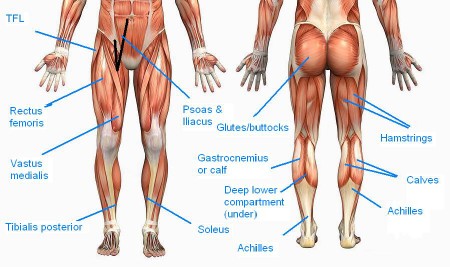
I first realized a major part of what’s been missing in the explanations of running experts and coaches when watching slow motion footage of Haile Gebrselassie. As his leg swings forward with purpose I look at his foot, curiously as his foot gets close to contacting the ground I can’t believe my eyes: it almost looks like the great Haile is about to heel-strike. But something happens in that very last phase before he contacts the ground: his thigh moves back slightly towards his body and his knee flexes a little more, suddenly that foot is in contact with the ground neutrally: what many people would call a mid-foot strike. Haile's foot contact was interesting, but the exciting part for me was the cause of the relative movement of his leg towards his body before ground contact.
The implications of this for me were serious, all my running life I’d been focused on landing, avoiding landing hard, wincing with every stride as I heel-toe crashed into the ground. The only way the great man Haile could make this movement happen was by activating the buttocks and hamstrings before contacting the ground. Now my hamstrings were more or less non-existent, not to mention my butt. It was no surprise; I already knew I ran almost exclusively with the muscles at the front of my legs and hips: the quadriceps and hip flexors. As I continued my research I found the knock-on effect of Haile’s early activation of the buttocks and hamstrings was much greater than positioning to foot-strike closer to the body. You could say it really is the key to good running technique, almost everything that follows stems from these fractions of a second before the foot contacts the ground.
Some have argued that human running ability is the primary driver of our success as the dominant species on the planet (Lieberman & Bramble, 2007). Whether you are a Darwinian atheist or believe in Intelligent Design, one has to admit the human ability to run fast for a long period is nothing short of remarkable. Consider this: the pace per 400 meters for the current men’s marathon (42.195 kilometers) world record (WR) is fractionally over 70 seconds per lap of a standard 400m athletics track. If we drop the distance down to 10,000 meters WR pace is about 64 seconds per lap. In kilometer terms this is 2.55km pace for the Marathon and 2.40 km pace for the 10,000m. The point is the pace does not drop off significantly, only about 8% between the 10,000m and the marathon; for a race that is over four times as long, this is stunningly sustained fast running. In the women’s event the results are no less compelling: 2.15.25 equates to 3.12 km pace compared to 2.57 km pace in the 10,000m.
So why is this significant to a discussion about running technique for normal runners like you and me? The answer is that humans are good at running, it’s engrained in our DNA, and this is good news as it means everyone can run. We might not all be able to move like an Olympian but we can run better. The problem is many of us don’t give our body the chance to move in a way that it is designed to move. When Haile’s hamstrings and buttocks activate before striking the ground, his muscles and tendons begin to engage in a way that easily absorbs landing forces and in each and every stride his body loads and releases energy stored in his tendons and muscles. I know I can’t do this as well as Haile does, but I can do it well enough to make improvements in my running.
Anthropologists have speculated that humans evolved certain biomechanical capabilities specifically designed to drive economical running performance (Lieberman & Bramble, 2007). Large buttocks, hamstrings and strong tendons capable of storing and releasing energy such as the Iliotibial tract and Achilles tendon, and the ability of the foot to load and release energy all make for efficient running. So why can’t we all run like the current Marathon WR holders Haile Gebreselassie and Paula Radcliffe? Obviously they are extremely talented, hard working athletes, but is there something mortals like you and I can learn from how elite runners such as Paula and Haile propel themselves over the ground with such apparent ease? In my view there is: we may not progress from being fun runners, or in my case D grade club athletes, to the Olympic Games, but we can harness the potential of our bodies by learning the fundamentals of efficient human movement. Herein is the pathway to more enjoyable injury free running.
The muscles involved in running. When I began trying to change my running technique I had no idea which muscles were supposed to be firing when. It was something of a mystery to me. This may sound strange to someone who is naturally gifted and has always run well, but it was a very real problem for me. Depending on your existing technical strengths and weaknesses, getting your running engine room firing with good timing might be a real challenge. I suspect many runners do grapple with getting this system of running right in their minds. This chapter gives you the complete picture of which muscles need to be firing when to generate the good technical elements discussed in chapter 4.
In addition to giving you a template for how running works, this knowledge will help you develop a basic strength and coordination program to help change or fine-tune your running technique. This is critical for narrowing your focus to exercises that strengthen the muscles needed for good running and practicing the coordination of smaller components of the running cycle. It is possible to use different muscles to produce similar movement patterns - my old quadriceps and hip flexor-dominated running technique is a good example of this. You need the gym practice to turn off the muscles that cheat and emphasise the muscles you want to be the prime movers, not only during strength and coordination training, but in your running. So your strength work-outs will have two distinct but complementary purposes: strength and coordination. Bringing the right feel from practicing specific movements during strength training can really help you activate the correct muscles. You’ll read more on this in chapter 7 and chapter 9.

This chapter also discusses the relative importance of each muscle group and the roles they play in terms of prime movement, energy return and stabilization. The figures used to illustrate technique and muscle activation are not intended to be anatomically perfect, they are roughly derived from observation and research. The range of motion I have illustrated is indicative of faster running (less then 3.30km pace). The muscle activation patterns are the same for slower running, however due to the lower forces involved, the range of motion of the limbs is less pronounced. So you don’t have to try and kick your bum with your foot if you are a 50minute/10km runner, or even if you are a 40minute/10km runner. The point is to use the illustrative muscle activation pattern as a template to discuss and engage correct running technique.
Measuring muscle activation patterns. In the previous chapter I outlined four phases of running and explained the visible signs of good and bad technique in each. Using this framework we can overlay the muscle activity involved in generating good running technique. The research in this area is based around using EMG (electromyography) technology that places electrodes into muscles that detect when the muscle is firing. The authors of the studies I have used then matched these readings to super slow motion video of the running cycle so they could pinpoint exactly when each muscle started and stopped working in relation to the movement pattern of the athlete. You can make a layman’s attempt at this by observing runners in slow motion or using still photography, often the key muscles working are visible to the naked eye.
EMG is one of those things you really don’t need to know in everyday life. I really didn’t want to understand what it meant, but it was the only way I was going to get some corroborating evidence (in addition to observation) to confirm which muscles were working during specific phases of the running cycle. The technique is useful, but not completely foolproof (Smoliga et al, 2009). I have used it to enhance my understanding of what is visible through close observation of photographs and slow motion video footage. EMG also struggles where the muscles are very deep, presumably due to the reluctance of volunteers to have a whacking great needle stuck in them. In one of the studies used in my discussion, the practitioner bemoaned the lack of willingness of their human guinea pig runners to have an electrode stuck in the psoas muscle. I can understand why, this muscle has its origin at the lumbar spine and then travels via the pelvis to insert onto the femur (thigh bone) - I wouldn’t be letting someone stick a three inch needle anywhere in that region!
Muscles need to work as a team: agonists and antagonists. Most of the muscles involved in walking and running in the body have an agonist and antagonist relationship (Cash, 2000); that is, when one pushes, the other pulls; when one flexes, the other may relax or play a support role. In running, this relationship between muscles is critically important to get right. The agonist is generally the prime mover for a particular movement e.g. the hamstrings in knee flexion (the agonist) and the quadriceps (the antagonist) which stabilise the knee while force is applied. Without the activation of the quadriceps while the leg is in contact with the ground, the knee would collapse as forces are applied by the hamstrings and glutes. Further, without the intervention of the hamstrings to decelerate the leg as it swings forward, the knee would over-extend (straighten) causing the leg to contact the ground straight and lead to potential injury.
During my research I discovered a phenomenon called antagonist co-activation: as the name implies, this means one set of muscles is firing at the wrong time in competition with another set of muscles trying to accomplish a particular task. For example: the quadriceps muscles working against, not with the hamstrings. Therefore, all the muscles in the legs and hips need to be strong, but also well coordinated to work efficiently during running. This is where the benefit of strength and coordination training is most profound - not in building absolute strength (although this helps), but in practicing the correct muscle activation patterns needed for efficient running.
Preparation. In the previous chapter I outlined the importance of activating the hamstrings and glutes, and generating slight movement of the leg back towards the body before the foot strikes the ground. But how does the body manage to achieve this? The simple answer is by using the combined strength and elasticity of the hamstrings, glutes and calf muscles. Research has shown through EMG readings that muscle activity in the hamstrings commences well before the foot contacts the ground (Mann and Hagy, 1986). Firstly, to brake the forward momentum of the swing leg and prevent over extension (straightening) of the knee joint and then secondly to begin dragging the leg back towards the body in preparation for contact with the ground.
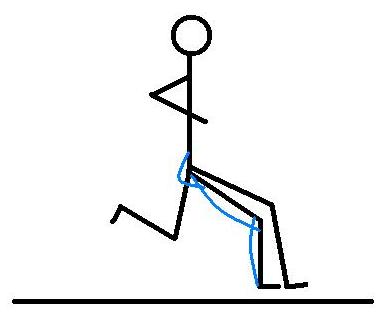
In the moments before ground contact the glutes also fire (buttock muscles - maximus first, then medius). The calf (gastrocnemius) also activates ahead of ground contact, mostly likely to help prevent over extension of the knee and pre-tension and stabilise the knee prior to ground contact. These muscles are all located at the rear (posterior) of the body and are largely responsible for generating forward thrust in running by propelling the body over the ground. I have drawn these three muscle groups onto the stick figures above and below to show their approximate locations.
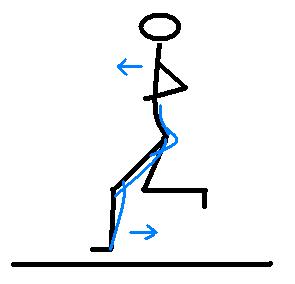
The glutes also help maintain back extension and optimal posture about the hip joint. We can see in the picture above that our stick runner’s back is upright and his hip will be flexed at the moment of contact with the ground. To further add to the importance of the glutes working during this phase of running, they help pull the thigh into alignment under the hip via the glute maximus attachment to the Iliotibial tract and the outside of the lower leg and the action of glute medius. Flex your butt and you’ll notice your knee flares out a little. The quadriceps group of muscles at the front of the thigh also begins working just before ground contact to stabilise the knee.
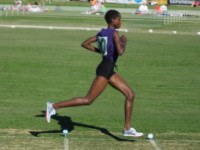
Contact. When I began researching muscle activity during the contact phase of running I discovered some very unusual findings. Initially the muscle activity is about what you’d expect - the hamstrings, glutes and quads are engaged at contact and continue to work to generate thrust, absorb impact forces and maintain stiffness and stability around the hip, knee and ankles joints. Where things get interesting from the EMG readings is that several key muscles apparently quit working well ahead of the foot leaving the ground. When I say key I mean the hamstrings and the calves. How can this be explained? I’ll get to that in a moment, but it does call into question a commonly held opinion that the foot leaves the ground because of powerful contraction of the calf muscle. The terminology toe-off is probably responsible for this belief as it implies popping off the ground via a flex of your calves similar to that responsible for standing on your tippy toes.
The next series of illustrations demonstrates how the muscles begin to “switch off” as the contact phase unfolds. In the initial part of contact force is applied to the ground when the muscles are most active and stored in the tendons and then it is released as these muscles switch off. This process helps explain why humans are so good at fast, sustained endurance running: for the energy we expend in every stride we get some free energy back. It’s not magic or perpetual motion as eventually even the best runner will get tired and this system will start to break down.
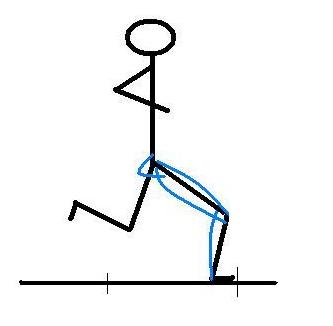
The leg contacts the ground full of purpose and stability with the hamstrings and glutes active to generate thrust and the quadriceps working to stabilise the knee and leg. This early phase is vitally important to absorbing shock and applying force and thrust into the stride. Therefore all the muscles needed to do this are active and working. One interesting muscle is the vastus medialis (part of the quadriceps group) - you can’t miss the high development of this muscle in elite runners. It is a key knee stabiliser, attaching onto the inside of the knee it provides support and resists the outward pull of the glutes - these two muscles work as a close knit team. The glutes are absolutely critical in this initial phase of contact with the ground. Compared to the hamstrings which are active for over half the time the foot is on the ground, the glutes only work hard for one-fifth of the total ground contact time.
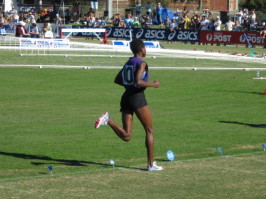
When I’m running really well it feels like my glutes lock in for a short period to stop my torso just rolling over the top of the thigh. Instead, my body drives ahead of the hip, the butt harnessing the full power of my hamstrings as they help extend the hips and flex the knee. Without it working well and at the right time you are literally leaking energy with each stride. The buttocks also help prevent the leg from over extending or getting too far behind the body and slowing the recovery of the leg into forward swing and the next stride. Upright posture helps get the glutes firing early and efficiently: leaning forward from the waist is the quickest way to slow down your running.

Because this phase is so important to absorbing shock and applying force, the posture of the foot and ankle becomes very important. It appears that the best runners do land with a forefoot oriented neutral foot and ankle posture: the foot has been shown to flatten (true pronation) and then stiffen as force is applied. A neutral landing provides the fastest and most stable base for this transition to occur. If the foot isn’t strong and stable then much of this force will dissipate and be lost. If you already have a good movement pattern established and you’re still looking for improvement, then examining your foot and ankle posture could yield good results.
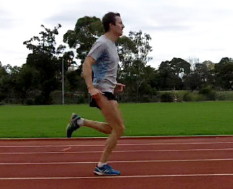
Saunders et al (2004) in their review of the literature around running economy identified research that suggests the achilles tendon and foot were capable of returning 35% and 17% of stored energy respectively. In their research, Lieberman et al (2010) demonstrated that barefoot runners with a forefoot/neutral landing orientation created lower levels of collision forces than runners wearing shoes landing with a pronounced heel-strike pattern. Both these findings imply changes here could yield big returns in performance and reduce injury in the longer term. However, these types of technical changes need to be approached with caution. For example, a gradual evolution from heel striking to neutral and finally a forefoot/neutral pattern could take place over a period of twelve months or more - see diagram below.
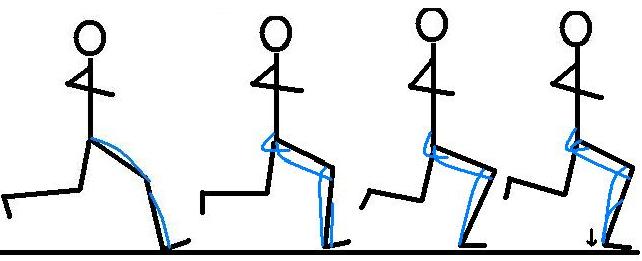
As running becomes faster the amount of flex that develops in the knee joint at this phase of contact varies considerably. At regular human speeds of 5 minute kilometer and 3.43 kilometer pace Mann & Hagy (1986) measured the knee dipping and flexing an additional 12 - 17 degrees during ground contact, however at elite speeds of 3 minute kilometer pace the amount of additional flex become negligible. The reason? Elite runners are able to maintain much greater levels of stiffness around the knee because their muscles are not only strong but working in good coordination, the knock-on effect is they are better able to utilise elastic energy stored in the muscles and tendons (Saunders et al, 2004). The concept of early activation of the glutes and hamstrings as the most important technical element to master in running is further supported by Leskinen et al, (2009) who found a positive correlation between rapid hip extension velocity and increased knee stiffness in the contact phase of running.
In the previous chapter I explained that the most stable and powerful posture around the hips for running is one where the thigh and foot are closely aligned under the hip – not the midline of the body. The muscle most responsible for this occurring is the glute maximus – the largest buttock muscle. It attaches onto the Iliotibial tract, which in turn attaches to the outside of the lower leg below the knee. This means when glute maximus contracts, the thigh and knee are pulled out from the midline of the body and under the hip. The second largest buttock muscle the glute medius also helps orient the hip in this posture.
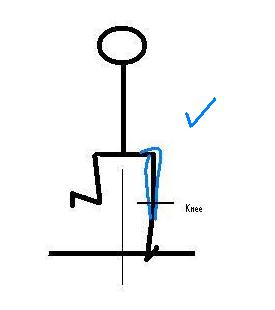
As ground contact continues the muscles that have performed their primary work start to power down, first the glutes and quadriceps (glute maximus first, then the quadriceps, then glute medius). The hamstrings and calves and lower leg muscles are all still working hard. Then as the thigh makes the transition into true hip extension the work is mostly done, the hamstrings and calves have quit applying force even though the foot is still in contact with the ground.
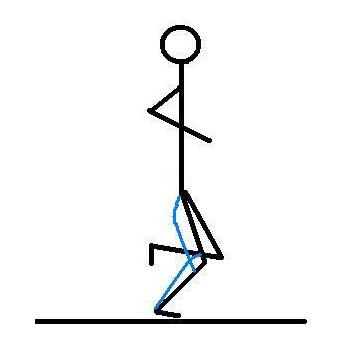
This is where EMG as a science becomes a little blind: I’ve seen enough footage of runners at this stage of the cycle to know that the muscles are still doing something, but I would argue that at this point they are returning some of the energy input at the beginning of the stride, rather than generating main force. It is interesting to note the muscles about the foot and lower leg work for longer than the bigger hip extensors to maintain a solid platform to propel the body forwards. This marries up with gait analysis of good runners whose feet leave the ground stiff (plantaflexed) and without much floppiness (dorsiflexion) developing. It also adds weight to the argument of runners interested in minimalist shoes or even barefoot running as a means to help develop foot strength, yes the muscles in the feet will strengthen, but also those in the lower leg (e.g. tibialis posterior that sits under the calf and soleus) that help plantaflex the foot. I discuss this later in the book so please don’t jump into running barefoot without reading some words of caution and explanation.
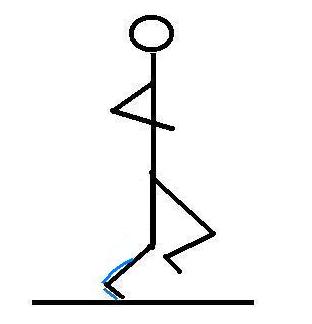
And in the final moments before the foot loses contact with the ground it’s all over and done, for a few blissful fractions of a second no work is being done by the muscles of the leg. The foot leaves the ground without additional positive work being performed by the calf muscle.
Back-swing. It might be tempting to think that there is little activity in the muscles during the swing phase and that they are sitting around resting waiting to paw at the ground; however this is not quite the case. Many muscles do take a break during swing; this is one of the reasons that people who generate a decent amount of distance between strides are more efficient in their running - the product of a more powerful longer stride. Remember though, that a long stride can be delivered from a compact powerful action - it does not need to be stretched out.
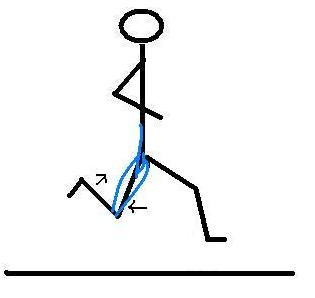
As the foot comes off the ground there is no muscle activity, but only for a few fractions of a second before the work begins again. The critical elements for good technique that we discussed in the previous chapter were rapid knee flex during back-swing and fast recovery of the thigh into hip flexion during forward-swing (thigh ahead of body mass). What we’ll discuss next are the muscles responsible for helping these movements take place.
The array of muscles working during swing is smaller than that during all other phases of running. The key thing to note that is that none of the quadriceps group is working during the swing phase, except for rectus femoris which kicks in to unfurl the lower leg at the knee during forward-swing. The major hip flexors Psoas, Iliacus and TFL kick in early to resist over-extension and begin getting the upper leg (thigh) working back towards flexion.
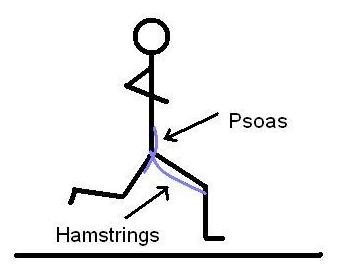
These are muscles that you don’t really need to be conscious of activating as they seem to be able to get firing on their own, most likely in response to the pre-stretch and loading through the forces generated during contact. Having good upright posture means these internal flexors that original on the pelvis and spine activate early through pre-stretch and operate in their correct range of motion. Another benefit of holding a long, upright spinal posture is to prevent the swing side hip dropping. Rectus Femoris in its first burst works on hip flexion (moving the thigh forwards) and then knee extension during forward swing.
Forward-swing. Faster leg recovery is definitely a goal to improve running performance, but the set-up for this to occur happens well before the foot leaves the ground. The faster the foot leaves the ground, the quicker the leg can be recovered during the swing phase. After the internal hip flexors – Iliacus and Psoas halt the movement of the thigh behind the body the hamstrings take over to continue flexing the knee and shorten the leg lever length and then and Rectus Femoris helps move the thigh forwards. At this stage of the cycle the internal flexors have ceased active work as the thigh moves forwards - again I believe they now return energy and help the hamstrings and Rectus Femoris to move the thigh forwards. Poor forward leaning (at the waist) posture will interfere with this release of elastic energy and make the forward swing slower, lower and less efficient. Holding good posture during this phase can also help prevent excessive internal rotation of the thigh from the hip joint.
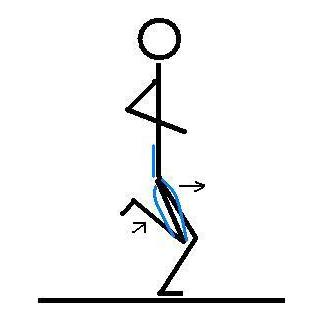
In the very last phase of forward swing the Rectus Femoris in generating positive work; however it has been shown that the spinal erectors are also quite active helping maintain this optimal posture for swing leg return in the forward swing phase of running. The hamstrings are now silent as are the internal hip flexors (e.g. Iliacus). As the leg straightens all muscle activity ceases and there is another short period of “rest” before the forward-swing phase ends and the preparation phase begins.
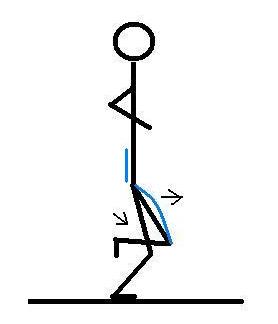
Implications for strength and coordination training. If we return to the analysis performed on elite1500m runners by Leskinen et al (2009), the authors speculated about the muscular activity that might corresponded to the various joint angles and velocities they measured. Their results included a finding that elite international level 1500m runners flexed their knees slightly less when on support than their national level counterparts (even running at similar speeds). Leskinen and colleagues inferred from this that the elite athletes were able to maintain greater stiffness around the knee joint and thereby utilize elasticity and stored energy to a greater degree that the national level runners. This finding is supported by Saunders et al, (2004) in their review of the literature around running economy. Leskinen and colleagues also found that the better runners extended their hips faster in the preparation phase of running (before contact) and flexed their knees faster during the swing phase. These findings confirm that the ability to use the hamstrings and glutes more effectively should be an area of focus for athletes of all ability levels.
If you are a 25 minute 5km runner wanting to run 20 minutes or a 15 minute 5km runner trying to run 14 minutes I would be focusing on the same areas. A runner with more talent can still improve, as demonstrated by the Leskinen study, which showed demonstrable and measureable differences between very fast runners on the cusp of being international standard compared to those already running internationally competitive times.
Stronger and better coordinated athletes have a better chance of improving in these areas - another reason why the strength training philosophy I have designed focuses on strength and coordination. The ankles, knees and hips need to be strongly engaged before and during ground contact to prevent force leakage at any of the major joints. Therefore it is important to include exercises that help your ability to maintain joint flexion (ankles, knees and hips) as movement takes place. Many trainers and athletes approach strength work by lifting something heavy from a flexed position to a fully extended position e.g. if you were using a leg press machine in a gym you often see people locking-out their knees. A better way to use this machine is to start and finish the range of motion in flexed positions so the movement becomes bouncy and never really stops - much closer to how running works.
While I’ve tried to make a compelling argument
about the importance of muscle function at various stages of the
running cycle, another way to look at the data collected by Mann
& Hagy, (1986) is to consider the total activity of the various
muscles across the complete running cycle. In a way this removes
contention about the exact role of certain muscles and brings it
back to a discussion about which muscles work the most over the
complete running cycle. So in order of greatest to least activity
over the running cycle:
- Hamstrings (62%)
- Rectus Femoris (49%)
- Intrinsic foot/lower leg muscles (38%)
- Gastrocnemius (calf 33%)
- Erector Spinae (back extensors 30%)
- Tensor Fascia Late (TFL hip flexor 25%)
- Quadriceps (21%)
- Glute Medius (20%)
- Iliacus hip flexor (17%)
- Glute Maximus (13%)
We can see the massive work being performed by the hamstring group. If there was any doubt about the importance of hamstrings in running, let the debate rest here. Ignore your hamstring strength at your peril. However, the hamstrings and glutes working together is key: without the glutes firing, much of the hamstring strength will be wasted through over-extension and instability of the hip joint. Therefore working on exercises that coordinate the hamstrings and glutes is critical to developing a better, more powerful and economical running technique.
****